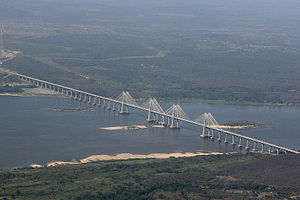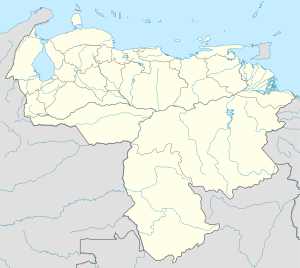Puente Orinoquia
Coordinates: 8 ° 16'31 " N , 62 ° 53'59" W.
| Puente Orinoquia | ||
|---|---|---|
| use | Road bridge | |
| Crossing of | Orinoco | |
| place | Ciudad Guayana | |
| construction | Cable-stayed bridge | |
| overall length | 3156 m | |
| width | 24.7 m | |
| Longest span | 2 × 300 m | |
| Clear height | 40 m | |
| start of building | 2001 | |
| completion | 2006 | |
| planner | Leonhardt, Andrä and Partner | |
| location | ||
|
|
||
The Puente Orinoquia (also called the Second Orinoco Bridge ) is a road and railway bridge over the Orinoco near Ciudad Guayana in the state of Bolívar in Venezuela . It is the second bridge over the Orinoco after the Puente de Angostura near Ciudad Bolivar about 120 kilometers by road upstream. The third bridge over the Orinoco, the Puente Mercosur , is expected to open in 2016; it is 480 km further upstream.
location
The Puente Orinoquia is around 40 km above the city center of Ciudad Guayana. The Orinoco is 1 kilometer wide at low tide and 2 kilometers wide at high tide. Its water level fluctuates by 12 meters over the course of the year. The two canals of the river run under the two main openings of the bridge. The bridge connects Ciudad Guayana and thus a large part of the state of Bolivar in the south of the river with the states of Anzoátegui and Monagas in the north of the river.
description
The Puente Orinoquia consists of two strung together, 1200 m long cable-stayed bridges with spans of 300 m in the main openings, as well as the 636 m long northern foreland bridge and the 1320 m long southern foreland bridge. The bridge structure is thus a total of 3156 m long. The bridge has two lanes each for vehicle traffic, which are separated by a single-track railway line in the middle. There are no bike paths or sidewalks. So far (2012) a railway track has only been installed on a short stretch for demonstration purposes.
The bridge deck is a total of 24.7 m wide. It is supported by a steel box girder with widely cantilevered struts that run across the entire bridge . The steel structure is connected to a 25 cm thick concrete slab. The H-shaped pylons of concrete are 119.2 m high. They stand on a 6 m high crossbeam, which in turn is based on numerous large bored piles . The legs of the pylons are stiffened below the bridge deck and in the area of the anchorages of the fan-shaped stay cables by 5 m high cross beams. Under the middle field between the two bridges there are vertical and inclined supports that stabilize the two bridges against the moving loads of the moving trucks and trains. For the same reason, supports are also arranged under the outer guy bays, which both carry loads and absorb tensile forces. The bridge deck was installed partly by pushing in and partly by cantilever .
history
The idea of a second Orinoco bridge has been discussed since 1966. In 1997 the construction was put out to tender under a BOT ( Build, Operate, Transfer ) contract, but after Hugo Chávez won the 1998 presidential elections, the bidders withdrew. Brazil's President Fernando Henrique Cardoso then offered Venezuela the financing of major projects. In a bilateral agreement, it was then agreed to finance the second Orinoco bridge through Brazil's Program for Exports of Goods and services (Proex) . The client, Corporación Venezuelana de Guayana (CVG) commissioned the Brazilian construction company Construtora Norberto Odebrecht , which has also been active in Venezuela for a long time, as general contractor for the planning and construction of the bridge. Leonhardt, Andrä and Partner produced the design on behalf of Odebrecht. Construction began in February 2001 on both banks of the Orinoco. At its peak, 3600 people were employed on the project, 97% of which came from Venezuela. The opening ceremony took place on November 13, 2006 in the presence of the Venezuelan President Hugo Chavez and the Brazilian President Luiz Inácio Lula da Silva .
In 2012, the media criticized that the railroad over the bridge had not yet been built and that the bridge itself showed significant damage from neglect.
Web links
- 2nd Bridge across the Orinoco Photos on the website of Leonhardt, Andrä und Partner
- Orinoquia Bridge. In: Structurae
- Cruzar el Orinoco graphic representation of the bridge on the website of El Universal (Spanish)
Individual evidence
- ↑ a b c Abstract by: Reiner Saul, Karl Humpf, Mauricio Lustgarten: The Orinoco Bridge in Ciudad Guayana / Venezuela - double cable-stayed bridge with composite superstructure for road and rail freight traffic . In: Stahlbau , Volume 75, February 2006, pp. 82–92
- ↑ a b Cláudio Lovato Filho: Unifying a nation, people and dreams ( Memento of the original from December 19, 2013 in the Internet Archive ) Info: The archive link was inserted automatically and has not yet been checked. Please check the original and archive link according to the instructions and then remove this notice. on the Odebrecht Informa Online website
- ↑ a b Imágenes muestran el abandono en que se encuentra el Puente Orinoquia Article of February 21, 2012 on noticias 24 / venezuela
- ↑ a b Cruzar el Orinoco drawing
- ↑ Description of the assembly with photos on the website of Dorman Long Technology (English)

